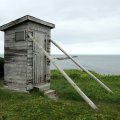GROS MORNE NATIONAL PARK
Park with remarkable geological formations, a variety of flora and fauna and offering various outdoor activities.
The jewel of the island, listed as a UNESCO World Heritage Site, the park stretches over 1,805 km², along the edge of the Long Northern Peninsula. It is internationally renowned for its exceptionally old geological formation, dating back 1,250 million years, and for the magnificent scenery offered by the tabular mountains of the Long Range, cut by fjords. On the narrow coastal strip, small fishing villages (Rocky Harbour, Lobster Cove, Baker's Brook, Sally's Cove, St. Pauls), cliffs, sandy or pebble coves follow one another. The park has two very different landforms: a coastal plain bordering the Gulf of St. Lawrence and an alpine plateau formed by the summit of the Long Range Mountains. They provide habitat for a variety of flora and fauna, constituting a unique assemblage of temperate, boreal and arctic species.
Bonne Bay. This is a deep fjord of sea water that splits into several arms, including the East Arm and South Arm. The South Arm offers magnificent views of fishing villages overlooked by the tabular heights of the Tablelands (altitude: 600 meters), with bare red ochre rocks emerging from the earth's crust. Near Woody Point, a viewpoint with explanatory panels offers a wide view of these formations. A trail leads into the heart of the Tablelands.
Lobster Cove Head. It is well known for its lighthouse. Its headland includes trails leading to coastal environments and tuckamore forests (conifers twisted by the sea winds). The headland is one of the best places in the park for whale watching and phenomenal sunset colors.
Broom Point. Traditional fishing facilities that reflect the lives of Newfoundland's inshore fishing families. Fishing exhibits, guided tours and interpretive activities are offered.
Outdoor activities. Hiking (the park's main activity), sea kayaking, mountain biking, cross-country skiing and snowshoeing are among the activities offered. With its network of over 100 km of trails, the park offers twenty or so hikes of all levels, from easy family walks to the most difficult hikes for experienced walkers. Some easy hikes: Broom Point (1 km round trip), Southeast Brook Falls (1 km round trip, through the woods to spectacular waterfalls), Green Point (3 km one-way, coastal trail), Berry Head Pond (2 km loop, bogs, forest), Berry Hill Pond (2 km loop, ponds, birds, frogs), Lobster Cove Head (1 km loop, beach, lighthouse keeper's house with exhibit). The trip to the Tablelands (4 km round trip, medium difficulty) allows you to see exceptional geology and flora. The hike to the summit of Gros Morne (altitude 806 meters) - 16 km, 7 to 8 hours of walking, difficult level - will allow you to discover an arctic-alpine vegetation and a particular fauna (arctic hare, ptarmigan).
Lodging. The park has five campgrounds, ready-to-camp oTENTik tents and rustic cabins. Self-catering accommodation is also available through private contractors at Trout River, Woody Point, Glenburnie-Birchy Head-Shoal Brook, Wiltondale, Norris Point, Rocky Harbour and Cow Head.
Did you know? This review was written by our professional authors.
Book the Best Activities with Get Your Guide
Members' reviews on GROS MORNE NATIONAL PARK
The ratings and reviews below reflect the subjective opinions of members and not the opinion of The Little Witty.


Stunning views
Pictures and video just cannot do justice to its unparalleled beauty. You get the mountains,ocean,beach,sandbanks,fjords,culture, beautiful sunset and sunrises all rolled in one when you visit the national park.
I say it's one of those places you should consider as a bucket list when exploring Canada.